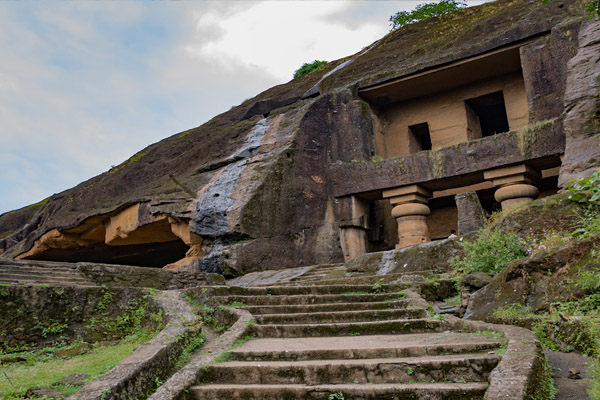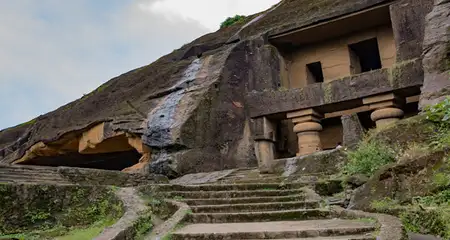Finding a quiet spot in the bustling city of Mumbai, where everyone is dreaming of winning the rat race against all odds, might seem impossible at first. But you will change your mind for sure when you visit Kanheri Caves. Nestled in the serene environs of Sanjay Gandhi National Park and surrounded by the Western Ghats, Kanheri Caves are a treat for historians, nature-lovers and peace-seekers. These beautiful rock-cut monuments in the form of caves or gufas are made of black basaltic stones. There is a total of 109 caves that can be accessed through a sequence of rock-cut steps. It is believed that these ancient caves were built between the 1st century BC and 10th century AD and they served as important pilgrimage and learning centres for Buddhist monks.
Exploring Kanheri Caves or Kanheri Gufas is a great way to learn about the prevalence of Buddhism in the western part of India. The gufas are adorned with brilliant ancient sculptures, paintings, carvings and inscriptions, and one of them has been transformed into a monastery as well. The cave complex is counted among the best places to visit in Mumbai.
Here’s some information about Kanheri Caves address, timings, entry fees and more.
Kanheri Caves Information, Mumbai
|
Location |
Sanjay Gandhi National Park, Borivali East, Mumbai, Maharashtra |
|
Type |
Caves |
|
Timings |
7:30 AM to 5:00 PM (Closed on Mondays) |
|
Entry Fee (per person) |
INR 15 for Indians; INR 200 for foreigners
|
|
Distance from Major Transportation Hubs |
Chhatrapati Shivaji Maharaj International Airport, Mumbai (23 km); Mumbai Central (40 km) |
|
Photography and Videography |
Allowed |
|
Year of Establishment |
1st century BC to 10th century AD |
|
Architectural Style |
Buddhist architecture |
|
No. of Caves |
109 |
|
Maintained by |
Archaeological Survey of India |
|
Material |
Black basalt stone |
Kanheri Caves’ location amidst the tranquil Western Ghats makes these caves quite popular among those who yearn to get away from the urban din. Before visiting these gufas, make sure you check Kanheri Caves’ timings and other information to avoid any confusion later. Kanheri Caves open early in the morning, at around 7:30 AM, and you can visit on any day from Tuesday to Sunday. The caves and their surroundings look serene and magical early in the morning, so try reaching before 9:00 AM. However, since Kanheri Caves’ opening time is subject to change, you need to enquire beforehand and plan accordingly.
Kanheri Caves: History
The word Kanheri was taken from the Sanskrit word Krishnagiri or Kanhagiri, which translates to black mountain (Krishna means black and giri means mountain).
Kanheri Caves or Kanheri Gufas are a collection of 109 rock-cut monuments, the earliest ones dating back to the 1st century BC. The history of these caves is also associated with the spread of Buddhism in the region. The gufas house many sculptures, paintings and inscriptions, suggesting that the cave complex was used by Buddhist monks for living, worshipping, studying scriptures and meditating. Hence, they were known as Buddhist Viharas as well.
The congregation halls in the caves feature large stupas which indicate that Kanheri Caves were considered important Buddhist shrines in ancient times. The caves reportedly were among the most important places where Buddhists settled during the 3rd century. According to historians and archaeologists, these caves were also used as rain shelters by monks.
Kanheri Caves: Architecture
Kanheri Caves boast an ancient Buddhist architectural style, with viharas, stupas, prayer halls and more. The most unique aspect of these caves is that they are carved out of a single bedrock. Although the architecture is quite simple, the caves are skilfully designed with important features, such as stone podiums for sleeping, channels to trap and store rainwater, tall pillars, walkways and so on.
Different caves here have different characteristics, like Cave 1 has an incomplete chaityagriha, while Cave 2 has three stupas and carved sculptures of Lord Buddha. In Cave 3, you will find a stupa, tall pillars and a large statue of Lord Buddha at the entrance. The caves also bear many inscriptions in Devanagari and Brahmi, much of which are still undeciphered.
Kanheri Caves: Today
Kanheri ki Gufa or Kanheri Caves are counted among the most important Buddhist heritage sites in the country, and hence, protected by the Archaeological Survey of India. The charm of these ancient caves and their tranquil location amidst lush greenery make the site a must-visit in Mumbai.
The caves are also quite popular among trekkers who can enjoy a 2-hour long trek through the verdant forest areas of Sanjay Gandhi National Park. The terrain is simple, scenic and perfect for beginners as well. Trekking in Kanheri Caves is probably one of the best things to do in Mumbai for nature lovers and adventure seekers.
Things to See in Kanheri Caves
The site houses a total of 109 caves, most of which are simple viharas or monasteries meant for praying, meditating and studying. However, some caves here will surprise you with exclusive designs and structures and are worth exploring.
- Cave 1: This cave is a vihara or Buddhist monastery. The cave is divided into two levels and the entrance has two pillars. This cave also houses an incomplete chaityagriha or prayer hall.
- Cave 2: This is a long cave that originally had three stupas or dagobahs, one of which has gotten damaged. The rocks around the stupas have sculptures of Lord Buddha.
- Cave 3: Known as the Chaitya cave or chaityagriha, Cave 3 is the most important gufa here. This remarkable cave has a well-sculpted screen that separates the front of the cave from the courtyard. Apart from the stupa and tall pillars, this cave has a large Buddha statue near the entrance.
- Caves 4, 5 and 6: Cave 4 reportedly is one of the oldest gufas here and Caves 5 and 6 are water cisterns.
- Cave 11: This cave is almost like Cave no. 5 in Ellora, Aurangabad. It was used by Buddhist monks for reciting religious scriptures.
- Cave 34: The ceiling of this cave is adorned with paintings of Lord Buddha, most of which are incomplete.
- Caves 41 and 67: These caves have sculptural images of Bodhisattvas. Both these caves have statues of the 11-headed Bodhisattva, Avalokiteshvara. The 11 heads represent the compassion of all Buddhas. Cave 41 offers glimpses of Jataka tales as well.
- Cave 90: This cave is the oldest and darkest one and is known for housing many statues of Lord Buddha. The walls of the cave have hundreds of statues, some of which depict Lord Buddha on the lotus throne, and some show him in the Padmasana or meditation pose.
Before visiting the caves, make sure you check online if Kanheri Caves are open today. Also, the caves are mostly closed in the afternoon time, i.e., from 12:30 PM to 2:00 PM, so plan your trip accordingly.
Lesser-Known Facts about Kanheri Caves
- The caves house about 30 incomplete paintings of Lord Buddha.
- Kanheri Caves, owing to their verdant surroundings, make for a great place to get fresh air in Mumbai.
- The site is popular for featuring the highest number of excavations from a single hill. The black basaltic rock was carefully carved out and the entire structure was built over centuries.
- The caves still serve as learning centres for Buddhists.
- The site has a cemetery on a secluded terrace.
Attractions Near Kanheri Caves
After you are done exploring the caves, you can head to the following attractions nearby:
- Sanjay Gandhi National Park
- Tulsi Lake (9 km)
- Mandapeshwar Caves (9 km)
- Shree Siddhivinayak Ganesh Temple (10 km)
- Dadasaheb Phalke Chitranagari (10 km)
- ISKCON Temple (12 km)
- Talao Pali Lake (15 km)
- Chota Kashmir Boat Club (16 km)
- Jogeshwari Caves (17 km)
- Mahakali Caves (20 km)
If you feel tired or hungry at any point, you can try one of the many local or multi-cuisine restaurants in Mumbai’s Borivali area. Street foods, such as Vada Pav, Misal Pav, Bombay Sandwich and more are a must-try. The city has many options for shopaholics as well, leaving no room for boredom. You can enjoy shopping in Mumbai for high-end brands as well as local products, since the options are endless.
To wrap up, Kanheri Caves Complex is a must-visit if you are a history buff, passionate about ancient architecture, interested in Buddhism, or simply love connecting with nature. Hence, whenever you plan a trip to Mumbai, including Kanheri Caves in your itinerary is highly recommended. In case you are flying to Mumbai or taking a train, remember to book your tickets in advance. Also, research stay options online and choose one beforehand. There are plenty of hotels in Mumbai near Kanheri Caves, so you can easily book one that suits your needs and budget.


















